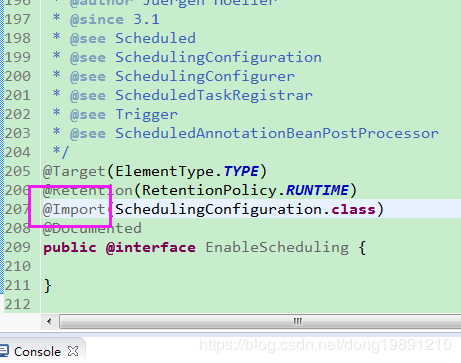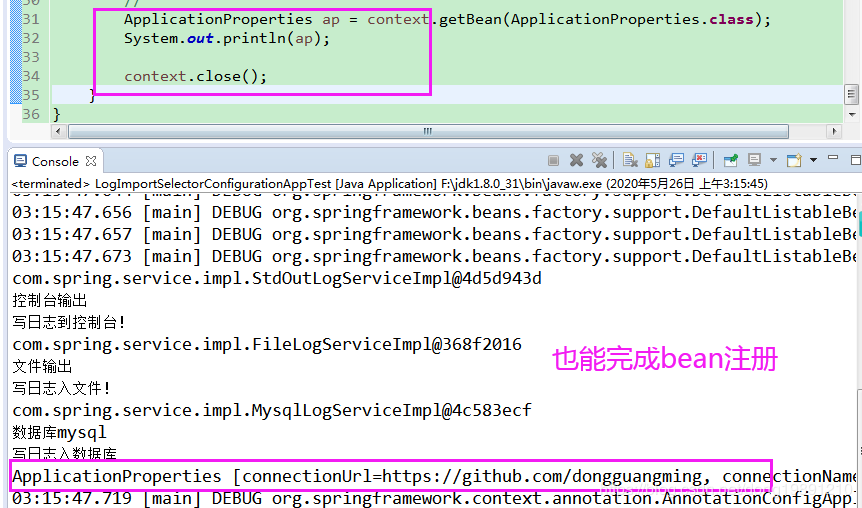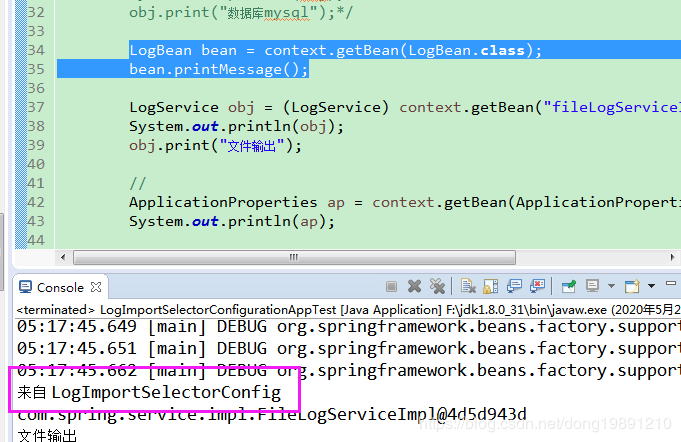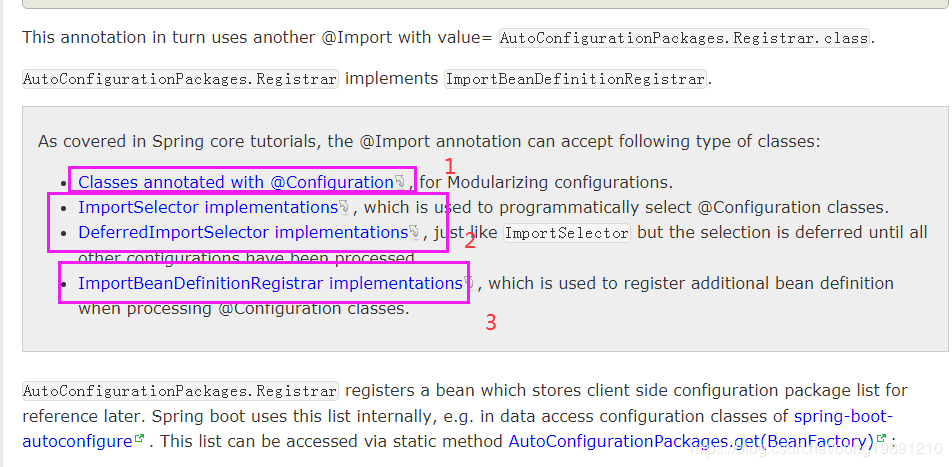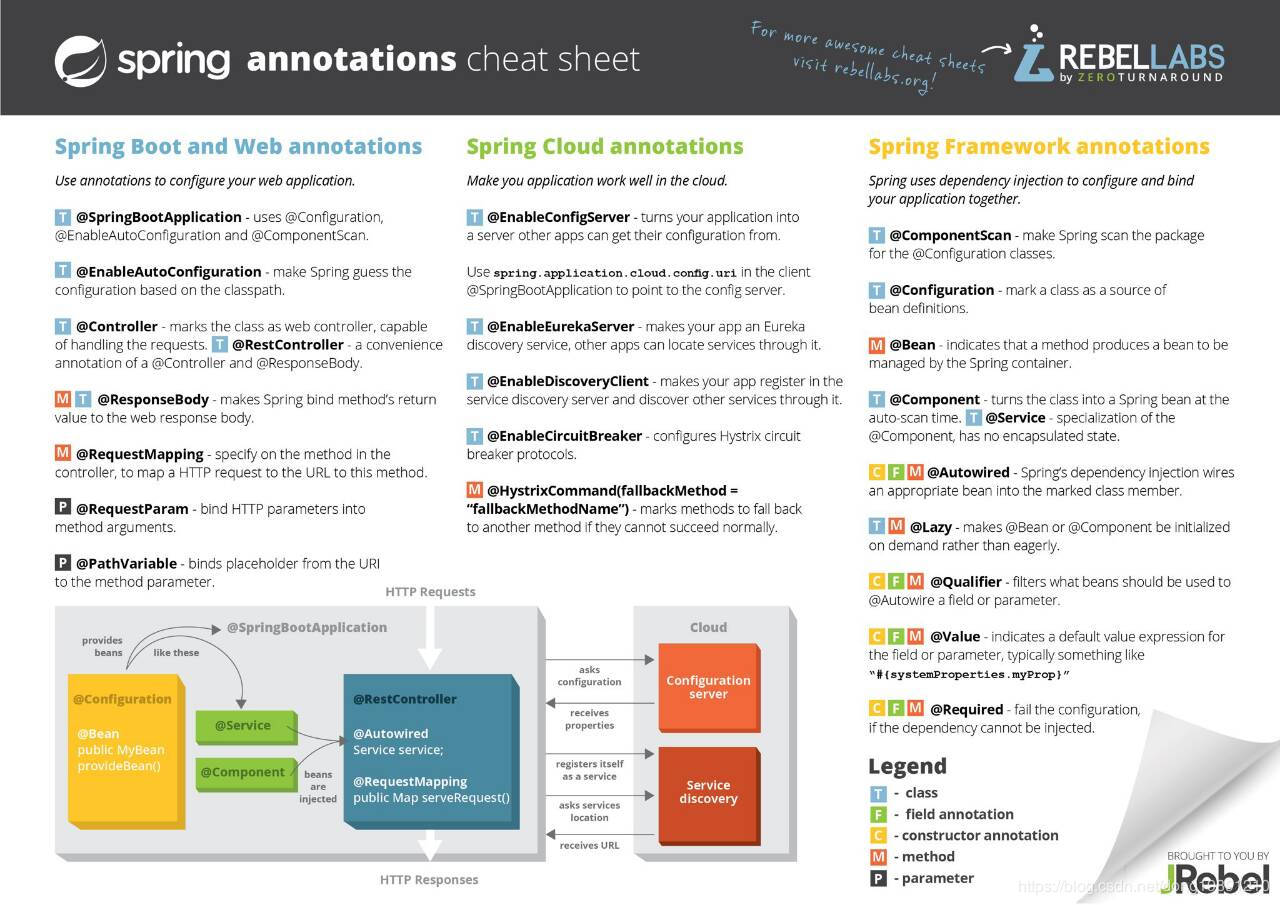Spring中@Import的三种情况
2020-05-26 16:01:06来源:博客园 阅读 ()

Spring中@Import的三种情况
我们在使用Spring框架中,特别是框架级的功能,经常看到有@Import导入功能,
我就介绍下它能导入什么,首先声明下@Import是注解,导入类型可分为三类:
1. 导入配置 @Configuration,类似于spring早期版本2.5的import xml文件一样,
<?xml version="1.0" encoding="UTF-8"?>
<beans xmlns="http://www.springframework.org/schema/beans"
xmlns:xsi="http://www.w3.org/2001/XMLSchema-instance"
xsi:schemaLocation="
http://www.springframework.org/schema/beans http://www.springframework.org/schema/beans/spring-beans-2.5.xsd
">
<import resource="cms-validator-service.xml"/>
<import resource="cms-validator-dao.xml"/>
</beans> 只是现在注解抢了风头,但目的一样,用于使用所有标有@configuration注解的配置。
下面我就写个小例子,怎么建java项目就略了
先建java主包com.spring, 然后分别建子包
com.spring.service, com.spring.service.impl, com.spring.config, com.spring.test1.1 建立服务接口
package com.spring.service;
/**
*
* @author dgm
* @describe "日志服务接口"
*/
public interface LogService {
void print(String message);
}1.2 建立服务实现类,分三种情况,控制台、文件和数据库mysql
package com.spring.service.impl;
import org.springframework.stereotype.Component;
import com.spring.service.LogService;
/**
* @author dgm
* @describe "日志到控制台"
*/
@Component
public class StdOutLogServiceImpl implements LogService {
@Override
public void print(String message) {
System.out.println(message);
System.out.println("写日志到控制台!");
}
}
import java.io.File;
import java.io.FileWriter;
import java.io.IOException;
import org.springframework.stereotype.Component;
import com.spring.service.LogService;
/**
*
* @author dgm
* @describe "日志到文件"
*/
@Component
public class FileLogServiceImpl implements LogService {
private static final String FILE_NAME="d://LogService.txt";
@Override
public void print(String message) {
try {
File file = new File(FILE_NAME);
FileWriter fw = null;
// true:表示是追加的标志
fw = new FileWriter(file, true);
fw.write(message+"\n");
fw.close();
System.out.println(message);
System.out.println("写日志入文件!");
} catch (IOException e) {
}
}
}
/**
* @author dgm
* @describe "写日志入mysql数据库"
*/
@Component
public class MysqlLogServiceImpl implements LogService {
@Override
public void print(String message) {
System.out.println(message);
System.out.println("写日志入数据库");
}
}
1.3 写配置类,三个服务实现类对应三个@Configuration
package com.spring.config;
import org.springframework.context.annotation.Bean;
import org.springframework.context.annotation.Configuration;
import com.spring.service.LogService;
import com.spring.service.impl.StdOutLogServiceImpl;
@Configuration
public class StdOutConfig {
@Bean(name="stdOutLogServiceImpl")
public LogService stdOutLogServiceImpl(){
return new StdOutLogServiceImpl();
}
}
import org.springframework.context.annotation.Bean;
import org.springframework.context.annotation.Configuration;
import com.spring.service.LogService;
import com.spring.service.impl.FileLogServiceImpl;
@Configuration
public class FileLogConfig {
@Bean(name="fileLogServiceImpl")
public LogService fileLogServiceImpl(){
return new FileLogServiceImpl();
}
}
import org.springframework.context.annotation.Bean;
import org.springframework.context.annotation.Configuration;
import com.spring.service.LogService;
import com.spring.service.impl.MysqlLogServiceImpl;
@Configuration
public class MysqlLogConfig {
@Bean(name="mysqlLogServiceImpl")
public LogService mysqlLogServiceImpl(){
return new MysqlLogServiceImpl();
}
}
然后@Import注解登场了
import org.springframework.context.annotation.Configuration;
import org.springframework.context.annotation.Import;
@Configuration
@Import({StdOutConfig.class, FileLogConfig.class, MysqlLogConfig.class})
public class LogParentConfig {
}1.4 建立测试类看效果
import org.springframework.context.annotation.AnnotationConfigApplicationContext;
import com.spring.config.LogParentConfig;
import com.spring.service.*;
/**
* @author dgm
* @describe "java configuration bean"
*/
public class LogConfigurationAppTest {
public static void main(String[] args) {
AnnotationConfigApplicationContext context = new AnnotationConfigApplicationContext(
LogParentConfig.class);
//控制台
LogService obj = (LogService) context.getBean("stdOutLogServiceImpl");
System.out.println(obj);
obj.print("控制台输出");
//file
obj = (LogService) context.getBean("fileLogServiceImpl");
System.out.println(obj);
obj.print("文件输出");
//mysql
obj = (LogService) context.getBean("mysqlLogServiceImpl");
System.out.println(obj);
obj.print("数据库mysql");
context.close();
}
}输出效果
2. 导入实现ImportSelector接口或子接口DeferredImportSelector的类
@Import annotation can also be configured with an ImportSelector implementation to select @Configuration classes programmatically, based on some selection criteria.
下面我也演示下,这个很重要,框架里和spring扩展开发用的多,先建立备用子包com.spring.bean和com.spring.importSelector,然后建立配置文件目录conf
2.1 实现了ImportSelector
2.1.1 建立辅助类ApplicationProperties.java和外置配置文件myapp.properties
package com.spring.bean;
public class ApplicationProperties {
private String connectionUrl;
private String connectionName;
public String getConnectionUrl() {
return connectionUrl;
}
public void setConnectionUrl(String connectionUrl) {
this.connectionUrl = connectionUrl;
}
public String getConnectionName() {
return connectionName;
}
public void setConnectionName(String connectionName) {
this.connectionName = connectionName;
}
@Override
public String toString() {
return "ApplicationProperties [connectionUrl=" + connectionUrl
+ ", connectionName=" + connectionName + "]";
}
}然后在conf目录下建立配置文件myapp.properties,内容如下:
app.url=https://github.com/dongguangming
app.name=dongguangming2.1.2 建立@Configuration配置类
@Configuration
@PropertySource("classpath:conf/myapp.properties")
public class AppConfig {
@Autowired
ConfigurableEnvironment environment;
@Bean
ApplicationProperties appProperties() {
ApplicationProperties bean = new ApplicationProperties();
bean.setConnectionUrl(environment.getProperty("app.url"));
bean.setConnectionName(environment.getProperty("app.name"));
return bean;
}
}2.1.3 建立实现了ImportSelector接口的导入类,返回列表里的值是有标志@Configuration
public class LogImportSelector implements ImportSelector{
@Override
public String[] selectImports(AnnotationMetadata importingClassMetadata) {
return new String[]{"com.spring.config.AppConfig","com.spring.config.LogParentConfig"};
}
}2.1.4 建立有@import功能的配置类,导入2.1.3的实现类
package com.spring.config;
import org.springframework.context.annotation.Configuration;
import org.springframework.context.annotation.Import;
import com.spring.importSelector.LogImportSelector;
@Configuration
@Import(LogImportSelector.class)
public class LogImportSelectorConfig {
}2.1.5 编写测试类
import org.springframework.context.annotation.AnnotationConfigApplicationContext;
import com.spring.bean.ApplicationProperties;
import com.spring.config.LogImportSelectorConfig;
import com.spring.service.*;
/**
* @author dgm
* @describe "java configuration bean"
*/
public class LogImportSelectorConfigurationAppTest {
public static void main(String[] args) {
AnnotationConfigApplicationContext context = new AnnotationConfigApplicationContext(
LogImportSelectorConfig.class);
// 控制台
LogService obj = (LogService) context.getBean("stdOutLogServiceImpl");
System.out.println(obj);
obj.print("控制台输出");
// file
obj = (LogService) context.getBean("fileLogServiceImpl");
System.out.println(obj);
obj.print("文件输出");
// mysql
obj = (LogService) context.getBean("mysqlLogServiceImpl");
System.out.println(obj);
obj.print("数据库mysql");
//
ApplicationProperties ap = context.getBean(ApplicationProperties.class);
System.out.println(ap);
context.close();
}
}输出效果:
效果不错,也能完成bean的注册
还有一种基于注解的变体,我也示例下,先建个子包com.spring.annotation
建立自定义注解:
@Target(ElementType.TYPE)
@Retention(RetentionPolicy.RUNTIME)
@Documented
@Import(LogImportSelector.class)
/**
* @author dgm
* @describe "自定义Enable功能"
*/
public @interface EnableLogService {
//默认日志输出到控制台
String logType() default "stdout";
@AliasFor("value")
String[] basePackages() default {};
@AliasFor("basePackages")
String[] value() default {};
}然后修改导入选择器实现类,根据启用日志功能时传的参数绝对加载哪个bean
AnnotationAttributes attributes = AnnotationAttributes
.fromMap(importingClassMetadata.getAnnotationAttributes(
EnableLogService.class.getName(), false));
System.out.println(attributes);
//根据日志类型确定加载bean
String logType = attributes.getString("logType");
if (logType.equalsIgnoreCase("StdOut")) {
return new String[] { "com.spring.config.AppConfig",
"com.spring.config.StdOutConfig" };
} else if (logType.equalsIgnoreCase("File")) {
return new String[] { "com.spring.config.AppConfig",
"com.spring.config.FileLogConfig" };
} else if (logType.equalsIgnoreCase("Mysql")) {
return new String[] { "com.spring.config.AppConfig",
"com.spring.config.MysqlLogConfig" };
} else {
return new String[] { "com.spring.config.AppConfig",
"com.spring.config.LogParentConfig" };
}修改配置类,追加自定义注解@EnableLogService,并设置参数为file(可选stdout,file,mysql)
@Configuration
//@Import(LogImportSelector.class)
@EnableLogService(logType="file")
public class LogImportSelectorConfig {
}修改测试类,此时不再是三种日志实现的bean都加载,按配置参数加载
LogService obj = (LogService) context.getBean("fileLogServiceImpl");
System.out.println(obj);
obj.print("文件输出");
就因为配置了@EnableLogService(logType="file"),只加载了一个日志实现bean
2.2 实现了 DeferredImportSelector
public interface DeferredImportSelector extends ImportSelector {
}可是看出它是2.1的子接口
The configuration class directly registered with the application context given preference over imported one. That means a bean of type T, configured in the main configuration will be used instead of a bean of the same type T from imported configuration. That applies to ImportSelector as well. On the other hand, DeferredImportSelector applies after all other configuration beans have been processed.
我们可以比较下实现两种接口的区别
在主选择器的配置类LogImportSelectorConfig.java中增加
@Bean
LogBean logBean() {
return new LogBean();
}
@Bean(name = "fileLogServiceImpl")
public LogService fileLogServiceImpl() {
return new FileLogServiceImpl(" 来自LogImportSelectorConfig ");
}
在文件配置类FileLogConfig.java中修改为
@Bean(name="fileLogServiceImpl")
public LogService fileLogServiceImpl(){
return new FileLogServiceImpl("来自 FileLogConfig");
}选择器实现类还是
public class LogImportSelector implements ImportSelector {。。。}执行测试代码
LogBean bean = context.getBean(LogBean.class);
bean.printMessage();
此时修改选择器实现的接口改为DeferredImportSelector,其它不改
public class LogImportSelector implements DeferredImportSelector {。。。}
再次执行测试
2.3 导入实现了ImportBeanDefinitionRegistrar接口的类
可以先瞄下接口的如何定义和定义了什么
public interface ImportBeanDefinitionRegistrar {
public void registerBeanDefinitions(
AnnotationMetadata importingClassMetadata,
BeanDefinitionRegistry registry);
}This Interface is to be implemented by types that register additional bean definitions when processing @Configuration classes.
具体可参考还记得我以前写的博文Spring Bean注册的几种方式https://blog.csdn.net/dong19891210/article/details/105798650吗,详细看第5.2小节,这里就不再重复啰嗦写了。
其实你搞懂了Bean,spring本身、及衍生的第三方扩展, 99.99%的问题都不再是问题了!!!
小结:一图
务必掌握好2和3,写扩展很有用,甚至spring本身都在大量使用。


spring围绕着bean运转的,注册的几种方式,每种注册方式的条件性选择
最后请慢慢学会忘记xml格式的配置文件,现在或往后都是注解式了,虽然xml配置并不影响功能!
附部分注解图一张:
参考:
0. @Import Annotation in Spring Framework
https://javabeat.net/use-import-importing-javaconfig-files-spring-projects/
1. Spring向容器注册Bean的高级应用 https://cloud.tencent.com/developer/article/1497795
2. how spring import annotation parse(要翻墙)??????? https://laptrinhx.com/spring-import-annotation-source-parsing-3074679655/
注意我说的墙不是下面这样的墙
原文链接:https://www.cnblogs.com/dongguangming/p/12963060.html
如有疑问请与原作者联系
标签:
版权申明:本站文章部分自网络,如有侵权,请联系:west999com@outlook.com
特别注意:本站所有转载文章言论不代表本站观点,本站所提供的摄影照片,插画,设计作品,如需使用,请与原作者联系,版权归原作者所有
- Spring系列.ApplicationContext接口 2020-06-11
- DES/3DES/AES 三种对称加密算法实现 2020-06-11
- springboot2配置JavaMelody与springMVC配置JavaMelody 2020-06-11
- 给你一份超详细 Spring Boot 知识清单 2020-06-11
- SpringBoot 2.3 整合最新版 ShardingJdbc + Druid + MyBatis 2020-06-11
IDC资讯: 主机资讯 注册资讯 托管资讯 vps资讯 网站建设
网站运营: 建站经验 策划盈利 搜索优化 网站推广 免费资源
网络编程: Asp.Net编程 Asp编程 Php编程 Xml编程 Access Mssql Mysql 其它
服务器技术: Web服务器 Ftp服务器 Mail服务器 Dns服务器 安全防护
软件技巧: 其它软件 Word Excel Powerpoint Ghost Vista QQ空间 QQ FlashGet 迅雷
网页制作: FrontPages Dreamweaver Javascript css photoshop fireworks Flash

